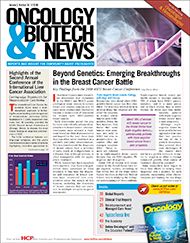Eli Lilly Lands Expanded Lung Cancer Latitude
Eli Lilly and Company has obtained FDA approval for an expanded indication of its anti-cancer agent Alimta. This new indication allows Alimta to be combined with cisplatin as a first-line treatment in locally advanced or metastatic non–small cell lung cancer (NSCLC) for patients with nonsquamous histology.
Click here to view as PDF.
Eli Lilly and Company, Indianapolis, Indiana, has obtained FDA approval for an expanded indication of its anti-cancer agent Alimta (pemetrexed for injection). This new indication allows Alimta to be combined with cisplatin as a first-line treatment in locally advanced or metastatic non—small cell lung cancer (NSCLC) for patients with nonsquamous histology.
This marks the third US indication for Alimta. In 2004, the drug received consecutive approvals, first in combination with cisplatin as a treatment in patients with malignant pleural mesothelioma whose disease is unresectable or who are otherwise not candidates for curative surgery; and then singly, as a second-line treatment in patients with locally advanced or metastatic NSCLC who have already undergone a chemotherapy regimen.
The expanded approval of Alimta comes after a phase III open-label randomized study demonstrated that Alimta plus cisplatin improved median survival for patients with advanced NSCLC of nonsquamous histology. The trial enrolled 1725 individuals with advanced NSCLC who received treatment with cisplatin plus Alimta or cisplatin plus gemcitabine HC1 for injection (Gemzar).
Patients in the Alimta arm had a median survival of 10.3 months versus 10.3 months in the gemcitabine arm (adjusted HR, 0.94; 95% CI, 0.84-1.05). The median PFS was 4.8 months for patients receiving Alimta and 5.1 months for those on gemcitabine (adjusted HR,1.04; 95% CI, 0.94- 1.15). Overall response rates were 27.1% for the Alimta cohort and 24.7% for the gemcitabine group.
A pre-specified analysis examined the impact of NSCLC histology on overall survival and observed clinically relevant differences according to histology. The nonsquamous cell NSCLC subgroup demonstrated longer median survival (unadjusted HR, 0.84; 95% CI, 0.74- 0.96) for the Alimta group (11.0 mo) compared with the gemcitabine group (10.1 mo). This trend was reversed in the subgroup of patients with squamous cell histology: median survival for the Alimta cohort was 9.4 months versus 10.8 months for the gemcitabine cohort (unadjusted HR, 1.22; 95% CI, 0.99-1.50). The unfavorable effect observed with pemetrexed on overall survival for patients with squamous cell histology was noted in a retrospective analysis of a single-agent trial that compared pemetrexed with docetaxel (Taxotere) in patients with stage III or IV NSCLC after prior chemotherapy.
In the current trial, patients treated with the Alimta regimen had less hematologic toxicity, received fewer blood transfusions, and demonstrated a decreased use of growth factors compared with those treated with the gemcitabine regimen.
Using the same data, the FDA approved a change to the second-line indication for Alimta that restricts its use to patients with locally advanced or metastatic NSCLC of nonsquamous histology who have undergone chemotherapy.
